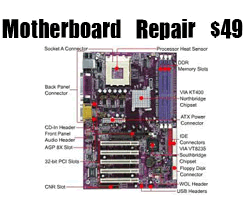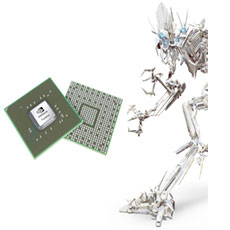Motherboard Repair Miami
Symptoms of bad motherboard
- No sound. no startup chime, alerts, or output from any sound software from the internal speaker or from the sound ou jack.
- Random app freezes requiring restart.
- With increasing frequency and within a smaller time from boot apps would begin to slow to crawl, windows would stop refreshing for minutes at a time, and then complete freeze.
- Onbard devices start acting strange. For example the network card simply does not react with the network although does get IP addrss; sound device will arbitrarily stop working or crash its device driver.
- USB connectors might stop working.
- RAM frequency reported incorrectly.
- BIOS information changes arbitrarily or resets.
- A software reset will crash with a blank screen.
- The system begins to boot but them powers down.
- An error message displays during the boot.
- The system becomes unstable, hangs, or freezes at odd times.
- Intermittent Windows or hard drive errors occur.
- Components on the motherboard or devices connected to it don’t work.
Faulty capacitors have been discovered in motherboards as old as Socket 7 in 1996 and have affected equipment manufactured up to at least 2007. The most common method of identifying capacitors which have failed because of bad electrolyte is visual inspection. The capacitance may degrade to 4% of the original value, as opposed to an expected 50% capacity degradation over the lifetime. Such a capacitor will show one or more of these symptoms like bulging of the vent on the top of the capacitor. The impression forms the seams of the vent. It is designed so that if the capacitor becomes pressurized it will split at the vent’s seams relieving the pressure rather than exploding, sitting crooked on the circuit board as the bottom rubber plug is pushed out, electrolyte a crusty brown substance leaked onto the motherboard from the base of the capacitor or vented from the top, visible as rust-like brown deposits, or a visible hole in the vent.
Faulty capacitors common symptoms are :
- Not turning on all the time; having to hit reset or try turning the computer on again.
- Instabilities hangs, BSODs, especially when symptoms get progressively more frequent over time.
- Memory errors, especially ones that get more frequent with time.
- Spontaneous reboots.
- In case of on-board video cards, unstable image in some video modes.
- Failing to complete the POST or rebooting before it is completed.
- Never starting the POST; fans spin but the system appears dead.
- Capacitors with high ESR can make power supplies malfunction, sometimes causing further circuit damage.

 Steven, L.
Steven, L.










